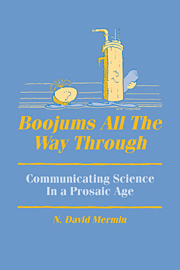Book contents
- Frontmatter
- Contents
- Preface
- I Reflections on the pursuit of physics
- II The quantum theory
- 10 Quantum mysteries for anyone
- 11 Can you help your team tonight by watching on TV?
- 12 Spooky actions at a distance: mysteries of the quantum theory
- 13 A bolt from the blue: the Einstein–Podolsky–Rosen paradox
- 14 The philosophical writings of Niels Bohr
- 15 The great quantum muddle
- 16 What's wrong with this pillow?
- III Relativity
- IV Mathematical musings
16 - What's wrong with this pillow?
Published online by Cambridge University Press: 02 December 2009
- Frontmatter
- Contents
- Preface
- I Reflections on the pursuit of physics
- II The quantum theory
- 10 Quantum mysteries for anyone
- 11 Can you help your team tonight by watching on TV?
- 12 Spooky actions at a distance: mysteries of the quantum theory
- 13 A bolt from the blue: the Einstein–Podolsky–Rosen paradox
- 14 The philosophical writings of Niels Bohr
- 15 The great quantum muddle
- 16 What's wrong with this pillow?
- III Relativity
- IV Mathematical musings
Summary
Attitudes toward quantum mechanics differ interestingly from one generation of physicists to the next. The first generation are the Founding Fathers, who struggled through the welter of confusing and self contradictory constructions to emerge with the modern theory of the atomic world and supply it with the “Copenhagen interpretation.” On the whole they seem to have taken the view that while the theory is extraordinarily strange (Bohr is said to have remarked that if it didn't make you dizzy then you didn't really understand it), the strangeness arises out of some deeply ingrained but invalid modes of thought. Once these are recognized and abandoned the theory makes sense in a perfectly straightforward way. The word “irrational”, which appears frequently in Bohr's early writings about the quantum theory, is almost entirely absent from his later essays.
The second generation, those who were students with the Founding Fathers in the early post-revolutionary period, seem firmly – at times even ferociously – committed to the position that there is really nothing peculiar about the quantum world at all. Far from making bon mots about dizziness, or the opposite of deep truths being deep truths, they appear to go out of their way to make quantum mechanics sound as boringly ordinary as possible.
The third generation – mine – were born a decade or so after the revolution and learned about the quantum as kids from popular books like George Gamow's. We seem to be much more relaxed about it than the other two. Few of us brood about what it all means, any more than we worry about how really to define mass or time when we use classical mechanics.
- Type
- Chapter
- Information
- Boojums All the Way throughCommunicating Science in a Prosaic Age, pp. 198 - 204Publisher: Cambridge University PressPrint publication year: 1990
- 3
- Cited by



